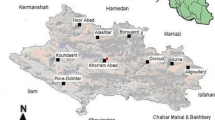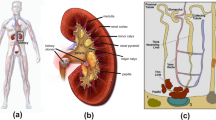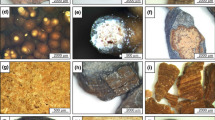Abstract
In order to understand the processes of stone formation, compositional, spectroscopic, mineralogical and crystallographic characteristics of human urinary stones collected from patients in Sri Lanka were investigated in detail. The data showed that the majority of urinary calculi were calcium oxalate, either whewellite or weddellite. Other solid phases of stones were composed of struvite, uricite and hydroxylapatite. However, mixed compositions were common except for whewellite stones which occur frequently in pure form. Scanning electron microscope observations and associated energy-dispersive X-ray analyses revealed that whewellite or weddellite was well crystalized compared to other stones types, while phosphate stones were mostly cryptocrystalline. The average δ13C and δ18O of stones were − 32.2‰ (− 37.3 to − 17.4‰) and − 24.2‰ (− 26.7‰ to − 8.9‰), respectively. The δ13C values were highly depleted compared to North American and European urinary stones. This may be due to food habits of Asians who consume rice as the staple food.





Similar content being viewed by others
References
Abboud, I. A. (2008). Mineralogy and chemistry of urinary stones: Patients from North Jordan. Environmental Geochemistry and Health, 30(5), 445–463. https://doi.org/10.1007/s10653-007-9128-7.
Abeywickarama, B., Ralapanawa, U., & Chandrajith, R. (2015). Geoenvironmental factors related to high incidence of human urinary calculi (kidney stones) in Central Highlands of Sri Lanka. Environmental Geochemistry and Health, 38(5), 1203–1214. https://doi.org/10.1007/s10653-015-9785-x.
Afaj, A. H., & Sultan, M. A. (2005). Mineralogical composition of the urinary stones from different provinces in Iraq. The Scientific World Journal, 5, 24–38. https://doi.org/10.1100/tsw.2005.2.
Antonakos, A., Liarokapis, E., & Leventouri, T. (2007). Micro-Raman and FTIR studies of synthetic and natural apatites. Biomaterials, 28(19), 3043–3054. https://doi.org/10.1016/j.biomaterials.2007.02.028.
Athanasiadou, D., Godelitsas, A., Sokaras, D., Karydas, A.-G., Dotsika, E., Xanthos, S., et al. (2017). New Insights into the chemical and isotopic composition of human body biominerals. II: COM kidney stones from Greece. International Archives of Urology and Complications, 3, 020. https://doi.org/10.23937/2469-5742/1510020.
Ayliffe, L. K., Cerling, T. E., Robinson, T., West, A. G., Sponheimer, M., Passey, B. H., et al. (2004). Turnover of carbon isotopes in tail hair and breath CO2 of horses fed an isotopically varied diet. Oecologia, 139(1), 11–22. https://doi.org/10.1007/s00442-003-1479-x.
Bazin, D., Chevallier, P., Matzen, G., Jungers, P., & Daudon, M. (2007). Heavy elements in urinary stones. Urological Research, 35(4), 179–184. https://doi.org/10.1007/s00240-007-0099-z.
Bellizzi, V., De Nicola, L., Minutolo, R., Russo, D., Cianciaruso, B., Andreucci, M., et al. (1998). Effects of water hardness on urinary risk factors for kidney stones in patients with idiopathic nephrolithiasis. Nephron, 81, 66–70. https://doi.org/10.1159/000046301.
Bhatt, P. A., & Paul, P. (2008). Analysis of urinary stone constituents using powder X-ray diffraction and FT-IR. Journal of Chemical Sciences, 120(2), 267–273. https://doi.org/10.1007/s12039-008-0032-1.
Cerling, T. E., Wittemyer, G., Rasmussen, H. B., Vollrath, F., Cerling, C. E., Robinson, T. J., et al. (2006). Stable isotopes in elephant hair document migration patterns and diet changes. Proceedings of the National Academy of Sciences of the United States of America, 103(2), 371–373. https://doi.org/10.1073/pnas.0509606102.
Chandrajith, R., Wijewardana, G., Dissanayake, C. B., & Abeygunasekara, A. (2006). Biomineralogy of human urinary calculi (kidney stones) from some geographic regions of Sri Lanka. Environmental Geochemistry and Health, 28(4), 393–399. https://doi.org/10.1007/s10653-006-9048-y.
Channa, N. A., Ghangro, A. B., Soomro, A. M., & Noorani, L. (2007). Analysis of kidney stones by FT-IR spectroscopy. JLUMHS, 6(2), 66–73.
Chatterjee, P., Chakraborty, A., & Mukherjee, A. K. (2018). Phase composition and morphological characterization of human kidney stones using IR spectroscopy, scanning electron microscopy and X-ray Rietveld analysis. Spectrochimica Acta Part A: Molecular and Biomolecular Spectroscopy. https://doi.org/10.1016/j.saa.2018.04.005.
Chelfouh, N., Grenier, N., Higueret, D., Trillaud, H., Levantal, O., Pariente, J. L., et al. (1998). Characterization of urinary calculi: In vitro study of” twinkling artifact” revealed by color-flow sonography. AJR. American Journal of Roentgenology, 171(4), 1055–1060.
Daudon, M., Bader, C. A., & Jungers, P. (1993). Urinary calculi: Review of classification methods and correlations with etiology. Scanning Microscopy, 7(3), 1081–1106.
Deganello, S. (1981). The structure of whewellite, CaC2O4·H2O at 328 K. Acta Crystallographica Section B: Structural Crystallography and Crystal Chemistry, 37(4), 826–829.
Durgawale, P., Shariff, A., Hendre, A., Patil, S., & Sontakke, A. (2010). Chemical analysis of stones and its significance in urolithiasis. Biomedical Research, 21(3), 305–310.
Echigo, T., Kimata, M., Kyono, A., & Shimizu, M. (2005). Re-investigation of the crystal structure of whewellite [Ca(C2O4)·H2O] and the dehydration mechanism of caoxite [Ca(C2O4)·3H2O]. Mineralogical Magazine, 69(1), 77–88.
Fraser, I., Meier-Augenstein, W., & Kalin, R. M. (2006). The role of stable isotopes in human identification: A longitudinal study into the variability of isotopic signals in human hair and nails. Rapid Communications in Mass Spectrometry, 20(7), 1109–1116.
Giannossi, M. L., Mongelli, G., Tateo, F., & Summa, V. (2012). Mineralogical and morphological investigation of kidney stones of a Mediterranean region (Basilicata, Italy). Journal of X-Ray Science and Technology, 20(2), 175–186.
Goonewardena, S. A. S., Nissanka, A. D. N. M., Kumari, M. I. P., Liyanage, M. R. P., & De Silva, B. S. S. (2006). Upper urinary tract stones: A case control study of fluid intake in first-time stone formers. Sri Lanka Journal of Urology, 7, 14–18.
Grases, F., & Llobera, A. (1998). Experimental model to study sedimentary kidney stones. Micron, 29(2), 105–111.
Hareendra, P. P. G., Hunais, M. M., Suvendiran, S., Palihakkara, S. D., & Abeygunasekera, A. M. (2015). Chemical composition of kidney stones obtained from a cohort of Sri Lankan patients. Sri Lanka Journal of Surgery. https://doi.org/10.4038/sljs.v33i2.8146.
Hesse, A. (2009). Urinary stones. In F. Lang (Ed.), Encyclopedia of molecular mechanisms of disease (pp. 2144–2147). Berlin: Springer.
Hoefs, J., & Armbruster, T. (1978). 13C/12C-Verhältnisse in menschlichen Harnkonkrementen. Naturwissenschaften, 65(11), 586–589.
Keshavarzi, B., Yavarashayeri, N., Irani, D., Moore, F., Zarasvandi, A., & Salari, M. (2015). Trace elements in urinary stones: A preliminary investigation in Fars Province, Iran. Environmental geochemistry and health, 37(2), 377–389. https://doi.org/10.1007/s10653-014-9654-z.
Krouse, H. R., & Levinson, A. A. (1984). Geographical trends of carbon and sulphur isotope abundances in human kidney stones. Geochimica et Cosmochimica Acta, 48(1), 187–191. https://doi.org/10.1016/0016-7037(84)90360-0.
Krouse, H. R., Levinson, A. A., Piggott, D., & Ueda, A. (1987). Further stable isotope investigations of human urinary stones: Comparison with other body components. Applied Geochemistry, 2(2), 205–211.
Levinson, A. A., Luz, B., & Kolodny, Y. (1987). Variations in oxygen isotopic compositions of human teeth and urinary stones. Applied Geochemistry, 2(4), 367–371. https://doi.org/10.1016/0883-2927(87)90021-7.
Levinson, A. A., Mino, M. P., Stams, U. K., & Hariharan, A. (1985). The mineralogy of human urinary stones from Calgary, Quito and Honolulu. American Mineralogist, 70, 630–635.
Lin-Vien, D., Colthup, N. B., Fateley, W. G., & Grasselli, G. G. (1991). The handbook of infrared and Raman characteristic frequencies of organic molecules. Boston: Academic Press.
Longinelli, A. (1984). Oxygen isotopes in mammal bone phosphate: A new tool for paleohydrological and paleoclimatological research? Geochimica et Cosmochimica Acta, 48(2), 385–390. https://doi.org/10.1016/0016-7037(84)90259-X.
Matsuzaki, S., Matsushita, K., Tanikawa, K., Masuda, A., & Matsunaga, J. (1995). Sequential analysis of recurrent calcium calculi by infrared spectroscopy. International Journal of Urology, 2(4), 235–237.
Maurice-Estepa, L., Levillain, P., Lacour, B., & Daudon, M. (2000). Advantage of zero-crossing-point first-derivative spectrophotometry for the quantification of calcium oxalate crystalline phases by infrared spectrophotometry. Clinica Chimica Acta, 298(1), 1–11.
Minagawa, M. (1992). Reconstruction of human diet from σ13C and σ15N in contemporary Japanese hair: A stochastic method for estimating multi-source contribution by double isotopic tracers. Applied Geochemistry, 7(2), 145–158.
Munoz, J. A., & Valiente, M. (2005). Effects of trace metals on the inhibition of calcium oxalate crystallization. Urological Research, 33(4), 267–272.
Nakamura, K., Schoeller, D. A., Winkler, F. J., & Schmidt, H. L. (1982). Geographical variations in the carbon isotope composition of the diet and hair in contemporary man. Biological Mass Spectrometry, 9(9), 390–394.
Nardoto, G. B., Silva, S., Kendall, C., Ehleringer, J. R., Chesson, L. A., Ferraz, E. S. B., et al. (2006). Geographical patterns of human diet derived from stable isotope analysis of fingernails. American Journal of Physical Anthropology, 131(1), 137–146.
Paluszkiewicz, C., Ściesiński, J., & Gałka, M. (1988). Analysis of renal stones by FTIR spectroscopy. Microchimica Acta, 94(1–6), 45–48. https://doi.org/10.1007/bf01205835.
Parks, J. H., Worcester, E. M., Coe, F. L., Evan, A. P., & Lingeman, J. E. (2004). Clinical implications of abundant calcium phosphatein routinely analyzed kidney stones. Kidney International, 66(2), 777–785. https://doi.org/10.1111/j.1523-1755.2004.00803.x.
Ries, J. B. (2010). Geological and experimental evidence for secular variation in seawater Mg/Ca (calcite–aragonite seas) and its effects on marine biological calcification. Biogeosciences, 7(9), 2795. https://doi.org/10.5194/bg-7-2795-2010.
Sekkoum, K., Cheriti, A., Taleb, S., & Belboukhari, N. (2011). FTIR spectroscopic study of human urinary stones from El Bayadh district (Algeria). Arabian Journal of Chemistry, 9(3), 330–334. https://doi.org/10.1016/j.arabjc.2011.10.010.
Selvaraju, R., Raja, A., & Thiruppathi, G. (2013). Chemical composition and binary mixture of human urinary stones using FT-Raman spectroscopy method. Spectrochimica Acta Part A: Molecular and Biomolecular Spectroscopy, 114, 650–657. https://doi.org/10.1016/j.saa.2013.05.029.
Sofia, P. G., Ionescu, I., Rodica, G., & Anisoara, P. (2010). The use of infrared spectroscopy in the investigation of urolithiasis. Revista română de medicină de laborator, 18(4/4), 67–77.
Swaddiwudhipong, W., Mahasakpan, P., Limpatanachote, P., & Krintratun, S. (2011). An association between urinary cadmium and urinary stone disease in persons living in cadmium-contaminated villages in northwestern Thailand: A population study. Environmental Research, 111(4), 579–583. https://doi.org/10.1016/j.envres.2011.01.007.
Talham, D. R., Backov, R., Benitez, I. O., Sharbaugh, D. M., Whipps, S., & Khan, S. R. (2006). Role of lipids in urinary stones: Studies of calcium oxalate precipitation at phospholipid Langmuir monolayers. Langmuir, 22(6), 2450–2456. https://doi.org/10.1021/la052503u.
Tokui, N., Minari, Y., Kusunoki, K., Yoshimura, T., Yamamoto, T., & Minagawa, M. (2000). Evaluation of dietary intake using carbon and nitrogen isotope analysis of human hair of Chinese living in southern part of China. Journal of UOEH, 22(3), 219–228.
Wandt, M. A. E., & Underhill, L. G. (1988). Covariance biplot analysis of trace element concentrations in urinary stones. BJU International, 61(6), 474–481.
Wijayarathna, K. S. N., & Abeygunasekera, A. M. (2013). Pathogenesis of nephrolithiasis. Sri Lanka Journal of Surgery, 31(3), 28–32. https://doi.org/10.1016/j.juro.2012.11.069.
Wumaner, A., Keremu, A., Wumaier, D., & Wang, Q. (2014). High incidence of urinary stones in Uyghur children may be related to local environmental factors. Journal of pediatric urology, 10(2), 289–293. https://doi.org/10.1016/j.jpurol.2013.09.002.
Zarasvandi, A., Carranza, E. J. M., Heidari, M., & Mousapour, E. (2014). Environmental factors of urinary stones mineralogy, Khouzestan Province, Iran. Journal of African Earth Sciences, 97, 368–376. https://doi.org/10.1016/j.jafrearsci.2014.04.031.
Acknowledgements
Dr. Stefan Krumm of GeoZentrum Nordbayern, Universität Erlangen-Nürnberg, is acknowledged for his help in XRD analysis. The study was performed with the approval of ethics committee at the Colombo South General Hospital, in compliance with the Helsinki Declaration. The authors declare that they have no conflicts of interest. This research study was funded by a research grant from the University of Peradeniya (RG/AF 2013/71/S) offered to RC and AS.
Author information
Authors and Affiliations
Corresponding author
Additional information
Publisher's Note
Springer Nature remains neutral with regard to jurisdictional claims in published maps and institutional affiliations.
Rights and permissions
About this article
Cite this article
Chandrajith, R., Weerasingha, A., Premaratne, K.M. et al. Mineralogical, compositional and isotope characterization of human kidney stones (urolithiasis) in a Sri Lankan population. Environ Geochem Health 41, 1881–1894 (2019). https://doi.org/10.1007/s10653-018-0237-2
Received:
Accepted:
Published:
Issue Date:
DOI: https://doi.org/10.1007/s10653-018-0237-2




